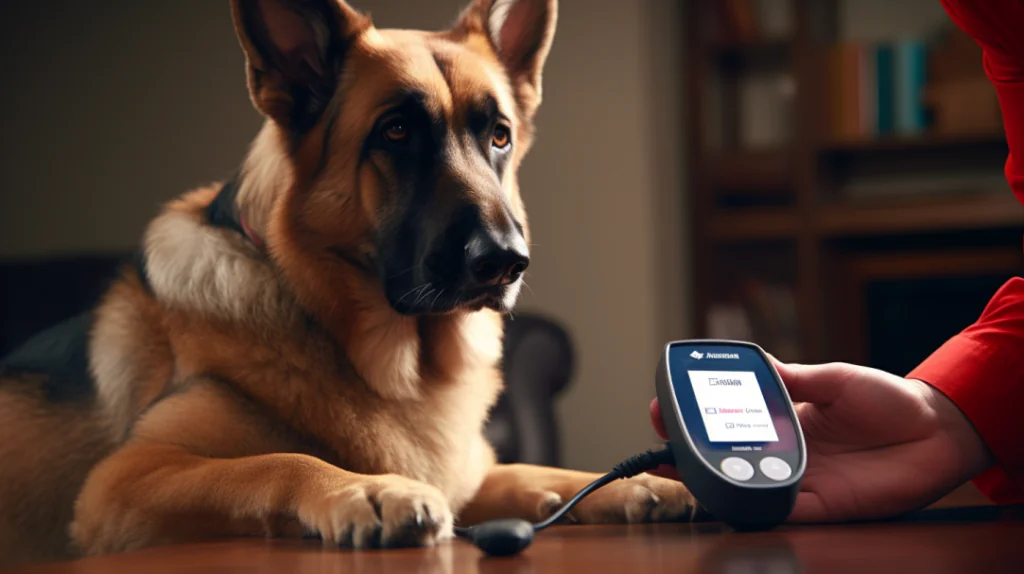Table of Contents
Are you a dog owner concerned about your furry friend’s health? Discover the key to managing diabetes in dogs with regular blood glucose dog testing. You can ensure they receive proper care and treatment by monitoring their levels.
Learn the importance of interpreting these results accurately and the different types of tests available. With the ability to monitor your dog’s blood glucose at home, you can prevent long-term complications.
Make regular veterinary check-ups a priority to ensure your dog’s well-being.
Key Takeaways
- Regular blood glucose testing is crucial for managing diabetes in dogs.
- Testing allows for timely adjustments to insulin dosage and diet.
- It helps identify patterns and trends in blood glucose levels.
- Maintaining blood glucose levels within the target range minimizes complications associated with diabetes.
Understanding Diabetes in Dogs
Diabetes in dogs is a condition that affects the body’s ability to maintain normal blood glucose levels. It occurs when the dog’s pancreas fails to produce enough insulin or when their body becomes resistant to insulin. Without insulin, glucose cannot enter the cells and builds up in the bloodstream.
Regular blood glucose testing is crucial for diabetic dogs. This allows pet owners to monitor their dog’s glucose levels and adjust insulin doses accordingly. It is typically done using glucose test strips and a glucometer. Blood glucose curves are often performed to assess how a dog’s glucose levels fluctuate throughout the day.
Maintaining proper glycemic control is essential for diabetic dogs. By carefully monitoring blood glucose levels, pet owners can ensure the right amount of insulin is administered to keep their dog’s blood sugar in the normal range. This requires regular veterinarian check-ups, as insulin requirements may change over time.
Diabetes in dogs can manifest in various clinical signs, including weight loss, increased water intake, and excessive urination. If left unmanaged, it can harm a dog’s overall quality of life.
Proper management of diabetes, including regular blood glucose testing and interpretation, is essential for the well-being of diabetic dogs. With diligent monitoring and appropriate insulin therapy, dogs with diabetes can lead happy and healthy lives.
Types of Diabetes
Diabetes mellitus, commonly referred to as diabetes, is a disease that affects dogs just as it does humans. There are two primary types of diabetes in dogs: type 1 diabetes and type 2 diabetes.
Type 1 diabetes occurs when a dog’s pancreas fails to produce enough insulin. Insulin is a hormone that regulates blood glucose levels and allows cells to absorb glucose as energy. Without sufficient insulin, glucose builds up in the bloodstream, leading to high blood sugar levels.
Type 2 diabetes, on the other hand, occurs when a dog’s pancreas produces insulin, but the body’s cells become resistant to its effects. This means that even though insulin is present, the cells cannot effectively absorb glucose.
Both types of diabetes can have profound health implications for dogs if not properly managed. Pet owners need to recognize the signs of diabetes in their dogs and seek veterinary assistance for diagnosis and treatment.
Increased thirst and water intake, excessive urination, weight loss despite increased hunger, lethargy, and frequent UTIs are indications of diabetes in dogs. Please see your vet if your dog has any of these symptoms.
Once diagnosed, the primary method of managing diabetes in dogs is through insulin therapy. Insulin is typically administered through daily insulin injections, and the dose may need to be adjusted based on regular blood glucose testing. Both type 1 and type 2 diabetic dogs require careful monitoring of their blood glucose levels to ensure their insulin dosage is appropriate.
Regular blood glucose testing with glucose test strips and a glucometer helps pet owners keep their dogs’ blood sugar levels within the normal range. This involves performing blood glucose curves, which create a graph of a dog’s glucose levels throughout the day. These curves aid in determining the optimal insulin dosage and timing for each dog.
Proper management of diabetes in dogs is essential for maintaining their overall health and quality of life. With careful monitoring of blood glucose levels, appropriate insulin administration, and regular veterinary check-ups, diabetic dogs can live happy and healthy lives. By understanding the different types of diabetes and the importance of normal blood glucose testing, pet owners can play an active role in their dog’s diabetes management.
The Role of Blood Glucose Dog Testing

You should regularly perform blood glucose testing to assess the effectiveness of your dog’s diabetes treatment. Monitoring your dog’s blood glucose levels is crucial in managing their diabetes and ensuring their overall health and well-being.
Here are the benefits of frequent testing:
- Early detection of high or low blood glucose levels allows for timely insulin dosage and diet adjustments, preventing potential complications.
- Monitoring blood glucose levels helps determine the effectiveness of the current treatment plan and identifies any necessary modifications.
- Regular testing provides valuable information about how your dog’s body responds to different foods, exercise, and stress, allowing for better management of their diabetes.
- By regularly monitoring blood glucose levels, you can better understand your dog’s unique patterns and trends, enabling you to make informed decisions about their care.
Why Regular Testing Is Important

Regular testing of your dog’s blood glucose levels is essential for effectively managing their diabetes. Regular monitoring can’t be overstated when handling your dog’s diabetes.
- By regularly testing their blood glucose levels, you can ensure that their insulin dosage is appropriate and adjust it if necessary. Early intervention is crucial in managing diabetes in dogs, as it can help prevent complications and improve their overall quality of life.
- Regular testing allows you to detect changes in their blood glucose levels and make timely adjustments to their treatment plan. It also helps you identify potential problems or trends requiring further medical attention.
- By monitoring your dog’s blood glucose levels regularly, you can stay proactive in managing their diabetes and provide them with the best possible care.
In the next section, we’ll discuss the different types of blood glucose tests available for dogs.
Types of Blood Glucose Tests for Dogs

To effectively monitor your dog’s blood glucose levels, it’s essential to choose the right type of blood glucose test and understand how to interpret the results. Different testing methods are available for dogs, each with benefits and considerations.
Here are some options to consider:
- Blood glucose meters: These handheld devices provide quick and accurate results by analyzing a small blood sample.
- Continuous glucose monitoring systems: These devices monitor blood glucose levels and provide real-time data, offering a more comprehensive view of your dog’s glucose fluctuations.
- Urine glucose testing: This method involves collecting a urine sample and using a test strip to measure glucose levels. It needs to be a more accurate method compared to blood testing.
- Home testing: Performing blood glucose tests at home allows for more frequent monitoring and can help establish a consistent routine for managing your dog’s diabetes.
Interpreting Blood Glucose Results
- When interpreting blood glucose results, it’s essential to consider the overall pattern of your dog’s normal levels and understand how they relate to their diabetes management.
- Interpreting test results involves analyzing the glucose fluctuations and identifying patterns or trends.
- Monitoring your dog’s blood glucose levels can provide valuable information about their response to insulin therapy and help guide treatment adjustments.
- Paying attention to high and low blood glucose levels is crucial, as both can have significant implications for your dog’s health.
- High levels may indicate inadequate insulin dosing or insulin resistance, while low levels may suggest insulin overdose or increased physical activity.
Target Blood Glucose Levels for Dogs
It would help if you aimed to maintain your dog’s blood glucose levels within a target range to manage their diabetes effectively. Here are some essential considerations for canine diabetes management and optimal blood sugar levels:
- The target blood glucose range for dogs with diabetes is typically between 100-250 mg/dL.
- Consistency is vital in achieving and maintaining these target levels.
- Monitoring your dog’s blood glucose levels ensures they’re within the target range.
- Your dog’s insulin dosage adjustments may be required based on blood glucose readings.
By keeping your dog’s blood glucose levels within the target range, you can help minimize the complications associated with diabetes.
Clinical Signs of Diabetes in Dogs
Increased thirst, urine, body weight loss, and appetite are indications of diabetes in dogs. Diabetics often have these symptoms due to blood sugar dysregulation. Polydipsia—increased thirst—occurs when the body urinates extra glucose. This excessive urination, or polyuria, can lead to dehydration if not properly managed.
Weight loss is a common clinical sign of diabetes in dogs due to the body’s inability to use glucose as an energy source. Instead, the body starts breaking down fat and muscle for energy, resulting in weight loss. Increased appetite, or polyphagia, occurs because the cells aren’t getting the glucose they need, leading to hunger signals to the brain.
If you notice these clinical signs in your dog, it’s essential to consult with a veterinarian for proper diagnosis and management of diabetes mellitus. Regular blood glucose testing and careful monitoring are crucial for maintaining your dog’s health and quality of life.
Signs and Symptoms of Poor Blood Sugar Control
Diagnosing diabetes in dogs involves recognizing classical signs, such as increased thirst, frequent urination, and changes in appetite or weight. Veterinarians carefully assess these symptoms, as well as blood glucose levels, to determine the time of diagnosis. Blood cells play a crucial role in evaluating glucose concentrations, and measuring insulin-producing cells can help differentiate between different types of diabetes.
Monitoring growth hormone levels can provide valuable insights, mainly when poor control is observed. A steady meal pattern is vital for long-term diabetic management. Veterinarians can accurately diagnose and treat diabetic pets by considering all these criteria.
Proper blood glucose control can help your dog avoid the signs and symptoms of poor blood sugar management. Maintaining stable blood sugar levels prevents complications and ensures your dog’s health and well-being.
When blood sugar levels aren’t properly managed, your dog may exhibit various signs and symptoms indicating poor blood sugar control. These include excessive thirst and urination, increased hunger, weight loss, lethargy, weakness, and recurrent infections. Your dog may have seizures, coordination issues, and coma in severe circumstances.
Regular blood glucose testing and close monitoring of your dog’s diet and insulin administration are essential for managing blood sugar levels effectively and preventing these complications.
Adjusting Insulin Dosage Based on Test Results

To effectively manage your dog’s diabetes, adjusting the insulin dosage based on test results is essential. Understanding diabetes and how it affects your dog’s blood sugar is vital for their health. Here are some key points to consider when adjusting insulin dosage:
- Regularly monitor your dog’s blood glucose levels to determine the effectiveness of the current dose of insulin.
- Consult with your veterinarian to analyze the test results and discuss any necessary changes in the insulin dosage.
- Adjust the insulin dosage gradually to avoid sudden drops or spikes in blood sugar levels.
- Record the insulin dosage adjustments and test results to track your dog’s progress.
Adjusting the insulin dosage based on test results ensures that your dog’s diabetes is adequately managed.
Minimizing Air Bubbles in Blood Samples
Diabetes in dogs is a medical condition that can affect their blood glucose concentrations and overall health. Diabetic dogs must have their blood glucose levels monitored to avoid complications. This often involves capillary blood obtained through a peripheral vein, typically by pricking the dog’s ear or paw to collect a small blood sample. Air bubbles in blood samples can affect the accuracy of glucose measurements, so it’s essential to ensure that blood samples are free from air bubbles during testing.
Proper technique and equipment, such as syringes and lancets, help minimize this risk. Urine output is another essential factor to monitor in diabetic dogs. Changes in urine output can indicate issues with kidney function, and measuring urine glucose concentrations can provide valuable information about blood sugar control. While corn syrup is not typically used in diabetes management for dogs, dog owners must be aware of potential hazards related to sugary foods and treats, as they can negatively impact a diabetic dog’s condition.
Proper disposal of medical sharps in a sharps container is essential in veterinary settings, just as it is in human healthcare, to ensure the safety of the veterinary team and prevent injuries and infections. In some cases, veterinarians may perform urine cultures to diagnose urinary tract infections or other urinary issues in diabetic dogs. These cultures help identify specific pathogens and determine appropriate treatment options. Diagnosing and treating dog diabetes requires strong collaboration with pet owners and the medical staff.
Monitoring Blood Glucose at Home
To effectively monitor your dog’s blood glucose levels at home, it’s essential to ensure the accuracy of your testing equipment. A reliable blood glucose meter designed for pets can help provide accurate readings.
Additionally, as your veterinarian recommends, it’s crucial to frequently test your dog’s blood glucose levels to gather enough data for proper interpretation and adjustment of insulin dosage. Regular home monitoring allows you to closely track your dog’s diabetes management and make adjustments to ensure optimal control.
Accuracy of Home Testing
It would help to use an accurate blood glucose monitor at home to ensure precise monitoring of your dog’s diabetes. Home testing has become an essential part of managing diabetes in dogs. However, it’s important to be aware of the limitations of home testing and consider alternative testing methods when necessary.
Here are some essential points to remember:
- Consistency: Test your dog’s blood glucose simultaneously daily to get reliable results.
- Calibration: Regularly calibrate your blood glucose monitor to ensure accurate readings.
- Comparison: Periodically compare your home testing results with those obtained at the veterinary clinic to ensure consistency.
- Consultation: Consult your veterinarian about home testing and ask for guidance on accurately interpreting the results.
Frequency of Testing
Make sure to monitor your dog’s blood glucose levels at home regularly to ensure proper management of their diabetes. The frequency of testing is crucial in maintaining stable blood sugar levels.
The timing of testing should be done consistently and at specific intervals throughout the day. Generally, it’s recommended to test your dog’s blood glucose levels at least twice daily, ideally before meals and insulin administration. However, more frequent testing may be necessary sometimes, especially if your dog’s diabetes isn’t well controlled. Your veterinarian will provide specific guidelines on the testing frequency based on your dog’s needs.
By monitoring your dog’s blood glucose levels regularly, you can make informed decisions about their insulin dosage and adjust their treatment plan accordingly.
Factors That Can Affect Blood Glucose Levels
During meal times, your dog’s blood glucose levels can be affected by various factors. These factors include:
- Type and amount of food: The kind of food your dog consumes can significantly impact their blood glucose levels. Carbohydrates, for example, can cause a rapid rise in blood sugar levels, while proteins and fats have a slower effect.
- Timing of meals: Feeding your dog regularly can help maintain stable blood glucose levels. Skipping meals or feeding irregularly can lead to fluctuations in blood sugar.
- Exercise: Physical activity can lower blood glucose levels in dogs. Monitoring your dog’s blood sugar before and after training is essential to ensure proper energy levels.
- Medications: Certain medications, such as insulin, can directly affect blood glucose levels. It’s crucial to administer medications as your veterinarian prescribes to maintain optimal blood sugar control.
Frequently Asked Questions
How Often Should Blood Glucose Testing Be Done in Dogs With Diabetes?
Regular blood glucose testing is crucial for dogs with diabetes. You can ensure their health and prevent complications by monitoring their levels frequently. Test as often as your vet recommends to maintain optimal control.
Can Blood Glucose Testing Be Done at Home, or Does It Require a Veterinary Visit?
You might wonder if you can do blood glucose testing at home or need to visit the vet. Good news! Home blood testing is possible, but it’s still important to consult with your veterinarian for proper interpretation and guidance.
What Are the Potential Risks or Side Effects of Blood Glucose Testing in Dogs?
When testing your dog’s blood glucose levels, you may experience potential risks and accuracy concerns. It is essential to be aware of these factors and consult a veterinarian for proper interpretation and guidance.
Are Any Alternative Methods to Manage Diabetes in Dogs Without Relying on Regular Blood Glucose Testing?
To manage diabetes in dogs without relying on regular blood glucose testing, alternative methods, and natural remedies can be used. These include dietary changes, exercise, and medication adjustments, which can help regulate blood sugar levels.
Are There Any Specific Dietary Recommendations for Dogs With Diabetes That Can Help Control Blood Glucose Levels?
There are specific dietary recommendations for dogs with diabetes that can help control blood glucose levels. Nutritional management is crucial in maintaining stable blood sugar levels and should be discussed with a veterinarian.
Conclusion
In conclusion, regular blood glucose testing is crucial to managing diabetes in dogs. By monitoring their levels, pet owners can ensure their furry companions receive the appropriate treatment and maintain a healthy lifestyle.
Like a compass guiding a hiker through a dense forest, these tests serve as a beacon of light, illuminating the path toward a well-regulated glucose balance. With consistent testing and veterinary check-ups, we can help our beloved dogs live a happier and healthier life.
Reader Advisory: This article, aimed at informational purposes, does not replace professional veterinary advice. While we aim for accuracy, we make no guarantees regarding the completeness or reliability of our content. Always consult a veterinarian before altering your dog’s diet or nutrition.




